Text
MUSC2653 Assignment 3 - Blog Post
Artistic Vision?
My artistic vision was to make the listener contemplate the Australian bushfires at the beginning of 2020. I wanted the listener to see how the bushfires had a global impact, not only with news coverage the world over, but also in the way that the fires displayed the negative trajectory that our world is on if we continued to ignore climate change. My artistic vision included a non-traditional execution, as I did not want to make the music sound just stereotypically sad and slow. I wanted the music to actually be more up-beat and catch the listeners attention in the ways that I would have re-invented the Passacaglia, the same way that I wanted to grasp the listener’s attention on the bushfire’s devastating impact. I felt that if I were to make a remix that sounded stereotypically sad, it would not stand out amongst the many other similar pieces of art aimed at showing the tragedy of the fires, and the listener might not truly be interested. I wanted to input shorter snippets of the original passacaglia recording to show the sadness, but then re-invent the music and make it very active to show the madness of nature’s response to society’s negligence to the environment. I worked on the remix in sessions, and below I have outlined the process diary of the first draft.
First Draft:
Session 1:
Introduction:
I began first with the original material of the passacaglia, taking the very first few sections of the original recording and placing it at the beginning of my remix. I made slight adjustments in the EQ to give more ambience in the sound, and this would serve to introduce the main chord progression of the original, or the material that I have developed on. Then I wanted to capture the audience’s attention, almost using the original passacaglia recording to mislead the listener into assuming the character of the piece is sad and the tempo is slow. I made a swell with a shimmering textured ‘wave space’ from the sound library and repeated a short sample of the more dissonant end of the passacaglia progression. I felt that the swell into the first section would be even more intriguing with a contemplative line of dialogue perhaps hinting at what the context of what artistic vision, but not completely giving away the topic of the bushfires. I inserted the line “It’s been an interesting year” from an interview on the Australian bushfires. This would help trigger interest in the audience and keep them listening intently in anticipation for elaboration on what exactly I was taking about.
Screenshot of Introduction:
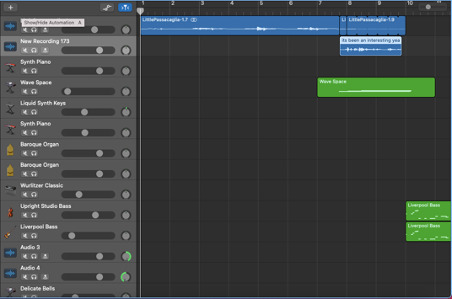
Session 2:
Section 1:
To depict the madness in my artistic vision, I first turned to a more active bass part, using faster notes and rhythmic syncopations whilst still retaining the general chord progression of the passacaglia (although I did add a dominant E major at the very end of the chord progression in order to have a very strong sense of harmonic direction). I wanted to make the bass more interesting and to have much more engaging textures, almost to give the bass a ‘satiric’ character amongst a more serious tone of the topic, so I used a double bass from the sound library for a warmer and ‘plucked -stringed’ sonority. I doubled that with a muted electric bass to enlarge the texture and depth of sound.
For the main melodic line of the piece, I used the original notes and range from the passacaglia. These more inviting and interesting sound qualities would be used for middle-ground placement. The main melodic line of the piece would retain the same rhythmic values as the original with crotchets and quavers but would not be syncopated as in the original. I did this to have more definition in the overall pulse of the music, which would help depict the directness of issue. I wanted a resonant sound to contrast the sound quality of the bass, so I went for ‘liquid synth keys’ in the sound library, and this contrast would define the main melody as the foreground.
To fill out the overall range of the piece and develop a more diverse range of sound effects in my background, I used a combination of thin and tinny sounding synth piano sounds and warmer, more sweet Wurlitzer classic synth pianos. I varied between these two in the first section depending on what assumed the foreground. I would use the thinner synth for when I had the resonant main melody, but I would use the Wurlitzer warmth for when I had dialogue. Thus, in this section the madness would be explored in the satirical activity of the bass and helped with thinner, shimmering sound effects, and the sadness would be explored in the wistful character of the main melody and encouraged by the resonance of synth sound effects.
Screenshot of 1st Section:

Transition to Next Section:
To keep interest in the piece, I wanted to music to gasp into the next section. This way, I would grasp the listener’s attention again, which is actually ‘word-painted’ in the line “when the fires affected them that’s what got the world’s attention”. I also wanted this transition to be more significant by having no music in the background, and thus reducing the texture suddenly for dramatic effect. This would anticipate the next section which was to be a change in mood.
Screenshot of Transition:
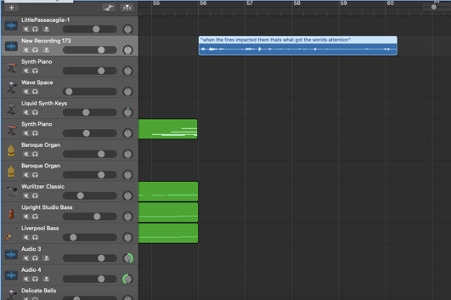
Session 2:
Section 2 – 1st Half:
In this next section, I wanted to contrast the mood of the first by making more of a sad character for the first half. To express the sadness of my artistic vision, I tried to further re-invent the bass by making it less active, holding longer more sustained notes but retaining the same chord progression. This line was put lower in the range of my remix, and I adjusted the EQ to have a more distorted, mutated and disgruntled bass, the harshness of sound of which was to depict the harshness of the bushfire’s heat. This would make the bass of this section the background layer.
The middle ground was the dialogue, which I took from news reports on the fires. The dialogue was to be presented like in the first section, with medium lengths of the audio files but I would sample shorter fragments of previous spoken dialogue and repeat them. This would be to keep the listening experience un-even, as the listener might have anticipated new dialogue to elaborate on from previous information present in another fragment, but that elaboration is presented later. This slight in-coherence and almost confusion was used to depict the haze of the smoke that would emerge from the fires, where the billowing white smoke would cover cities all over Australia and paint the sky ‘apocalyptic’ red.
Joining the dialogue in the middle ground, I used a ‘synth bell’ thin, piercing texture from the sound library to contrast the textures of the thicker bass. I then quoted the melodic material from the middle section of the passacaglia, which is the same as the melody of the first section just a third higher. I then explored greater diversities of sound by placing the same melody with a harp setting and a marimba setting from the sound library.
In this half-section, the melody would be the foreground, the bass the middle-ground and the sound effects and the dialogue being the background. The melody would now be more ‘active’ with a greater variety of ‘toy instrument’ sounds like the marimba and the harp, almost comically piercing to depict the madness, whilst the bass depicted the sadness, and thus inverting the roles of the 1st section.
Screenshot of Section 2 – 1st Half

Session 3:
Section 2 – 2nd Half:
Towards the end of the 1st half, I stumbled upon an idea where I displaced the harp and marimba melodies, so it sounded like a canon. I decided to expand on this further in the second half by adding a third voice with a plucked synth texture from the sound library. I built up to the three-voice canon by gradually layering each melody and building the texture. I re-invented the bass further to give it more activity with more leaping intervals. I combined aspects of instrumentation from both the first half and the first section, by using the mutated bass sound and the double bass sound from the first section together. The bass and the melodic materials would then be the foreground. For the middle ground I added the ‘Wurlitzer’ sound from the first section, where it plays moving thirds and expands on the harmonies implied by the new bass progression. Overall, I wanted this entire half section to be a gradual build up to a very thick texture with lots of frantic activity in each layer. This was thus created with a gradual build-up of melodic voices to the canon, paired with the jumping bass and gradually increasing textures in the background, as I was trying to depict how the bush-fires could grow exponentially and spread very quickly until chaotic. I also used repeating samples of dialogue under different ambiences, and then layered long speeches of dialogue over each other to further this idea.
Screenshot of 2nd Section – 2nd Half
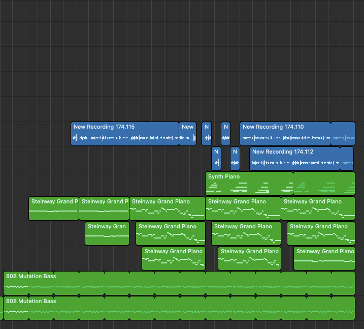
Transition into 3rd Section:
Just like the first transition, I wanted the texture to suddenly decrease and for another poignant line to be made. The line would be “so for me its been a long year, of realising how nature can strike back”. In the background of the original dialogue sound source, there was a pedal swell on the note A, so I expanded on that by doubling two sets of organ sounds that gradually crescendo with the audio file. At this point, I had not started a third section, but I assumed that this swell would be a good transition, just like I believed it was for the introduction at the very start.
Screenshot of Transition into 3rd Section:
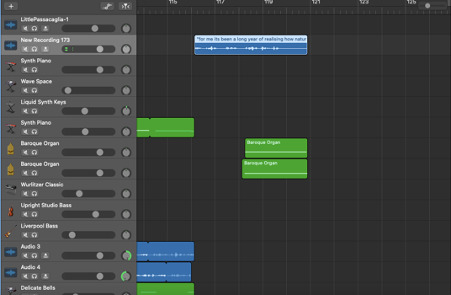
Second Draft
After I had received feedback from my teacher, I made changes to my piece. This was the first way that I sought advice from an external source on how to improve my remix. Below are the rest of the sessions I had on the remix working to improve different sections, as well as some reflections on the challenges and inspirations I had along the way.
Session 4:
Introduction to Section 1:
My teacher informed me that I should use audio files of dialogue from aesthetically pleasing or good quality sound sources. If possible, I should try to make the voice quality of the person talking much more pleasing. I found a better voice quality, but changed the line to “in 2020, Australians have been tested like never before”, which I believe is still poignant enough to still capture the audience’s attention.
Screenshot of Introduction (Revised):
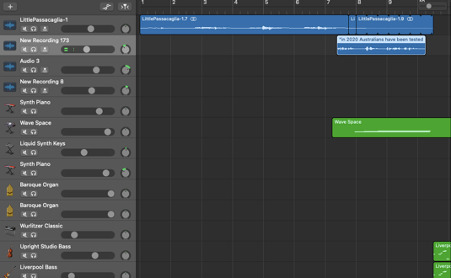
Introduction in Section 2:
My teacher informed me that whilst he liked my transformations of the original passacaglia, if the listener had never heard the original piece before, they might not be able to appreciate all the re-inventions I made and thus the correlation between the original and my remix would be absent from a ‘lay-man’ listener’s perspective. So, I decided to add more of the original passacaglia recording, but I wanted a sample from a different part of the piece to what I used in the introduction, and so I used audio from the section where the main melody is first heard. This helped demonstrate the original context from where my remix has been forged, and to re-enforce the ‘sadness’ aspect of my artistic vision. I found this a little bit challenging however, as I was originally thinking of more complex ways of integrating this that would seem more purposeful and effective. This was also challenging because in the first draft I had not completed the minimum 6 minutes, so I wasn’t exactly sure about where my potential third section would go. I tried to slow down or significantly alter the EQ and the sound of the original, but it was very difficult to do and eventually I realised that I in fact needed the original untouched because that’s how the listener will fully comprehend the original. If I were to alter it too much, it would still seem distant from the remix’s reinventions. In this way, the act of trying to alter the original file was a dead-end.
I have previously mentioned that I wanted to take a less stereotypically sad and slow approach to the remix, but I later realised that having more short clips of the original might work better to allow the audience to feel the sadness more sincerely, as otherwise the frequency of the ‘comically satiric’ nature of the rest of the remix might mis-communicate my intentions. I had even tried to look for solutions on YouTube, following many tutorials on how to make samples slower or more distorted, but in the end it was still very difficult for me to do. Therefore, I originally failed to effectively communicate the overall characterisation of the remix in my first draft.
Also, extending these transitions with the samples from the original passacaglia recording also helped to improve structural definition in my remix. My teacher commented on how it felt better to re-introduce the audio if I already had it at the very beginning, because it helped the audience have time to absorb all the things they just experienced in the previous section before moving on. Otherwise, the fast changes between dramatic sections could make everything sound less significant. From this feedback, I was inspired to make changes to all my transitions.
My teacher also recommended that I vary the content of my dialogue a bit more. This would better show that this was a global issue in terms of demonstrating the overall re-percussions of climate change, as I originally wanted to in my artistic vision. He suggested that I could have news reports with people speaking in different accents. This way, by showing the global news coverage of the bushfires, I would allow the listener to contemplate the vast severity of the fires better, as the natural assumption is to think the fires would still have only effected or be relevant to Australia. I used an American news report comparing the amount of land the bushfires had destroyed to the sizes of American states.
The need to find a wider variety of news reports influenced my recording strategies. I mostly found these clips from YouTube, so the strategy I used to record these was just to use my iPhone voice memo app. The sound quality was not the clearest but that actually helped as each of the dialogue samples I had, I wanted to sound a little distorted and a little ambient, especially during sections where I quoted the original Passacaglia recording directly. These non-ideal sound qualities helped enhance the sadness and harshness of sound that I wanted to elaborate on from my artistic vision. Moreover, I had to use this recording strategy as it was the easiest way to quickly and effectively record samples, as many times I found it challenging to find news reports or speech in a documentary that did not already have background music, and so as soon as I was finally able to find the perfect sample, I recorded it straight away.
Screenshot of Introduction into Section 2 (revised):
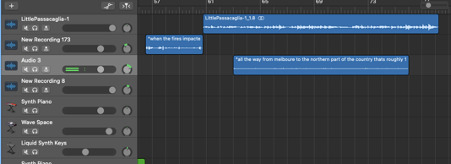
Session 5:
2nd Section:
My teacher suggested that I use my dialogue more effectively, where I should try and place longer samples or more text over music that wasn’t too active underneath. This would mean that I could more effectively manage texture roles, where the text and main melodic material could take turns assuming the foreground, and the dramatic potentials of the music would be better realised. So, I placed longer text sequences over less thick musical textures and used much shorter fragments of audio samples when the musical textures were more active. In the first half, I included a British news report of the Australian fires which described the smoke of the fires being seen from Chile. This further enhanced the depiction of the fires and of climate change as a global issue. I used fragments of 3 of the news reports that the listener would have previously heard, with the words “fires”, “kill” and “awake at night”. These fragments were not only to increase dramatic effect but were also used to compound the gradual increase and over-condensation of musical textures and activity that I was aiming for at the end of the 2ndsection in depicting the large and quick chaotic growth of the fires. I also panned each layer of the texture slightly different, so that not only could you hear each layer distinctly even when over-condensed, but also to create a more multi-dimensional listening experience. I was inspired to use the panning here, and then consequently in subtle ways throughout the remix, from videos on YouTube that talked about how to make your song or remix more multi-dimensional.
Screenshot of 2nd Section (top half – revised):
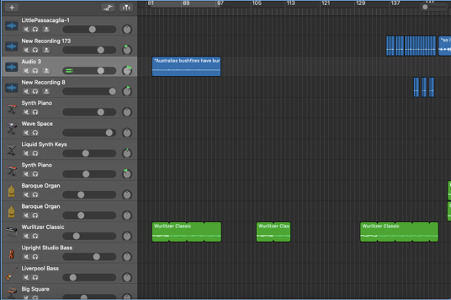
Screenshot of 2nd Section (lower half – revised):

Session 6:
Transition into 3rd section
Just like the transition into the 2nd section, I extended the transition into the 3rd section with more of the original passacaglia. However, I needed to have a clear idea of a 3rd section if I was going to continue this piece and make this transition significant. I decided to make this section about people’s response to the fires, specifically the reaction of celebrities, as I believed that more than the people who are the most effected by the issue, those with fame and a platform are focused on in giving a response to the issue. I focused on the coverage of the issue from the golden globes. I included a speech by an actress in the transition into the third section to show the awareness that people now have of the dangers of climate change. I found it challenging however to incorporate a new section in the middle of the remix, as I would often have to select all the tracks from a certain point on and shift them further ahead in the remix. This was also difficult to repeatedly do, as sometimes I realised that I wanted more or less extra space for developing or adding a new section and so I’d have to shift all the tracks again and again.
Screenshot of Transition into 3rd section (revised):

Third section:
I originally found it very challenging to think of what to create for the third section, as the ideas for the first two flowed pretty easily. I found that I wanted to make a new point in the remix’s topic. I wanted to make the third section very much a reprise of the first in terms of melodic content. I wasn’t focused on re-inventing the music yet another way as much as I was trying to round of the piece with content that was familiar to the listener at that stage in the remix.
The transition into the 3rd section was to foreshadow talking about the response from people to the fires and to the issue of climate change. However, I wanted to make the listener consider more of the complexities in people’s responses, and I brought up the debate of how people of fame and power may try and help after the damage is done, but they do not see the warning signs and act beforehand so that the issue can be prevented in the first place. This debate was central to the golden globes award ceremony that took place around the same time as the bushfires.
I was also inspired to make the textual content of this section after watching news reports on bushfire victims’ interactions with the prime minister. The scene of their homes having been destroyed, and the men, women and children being tired and disturbed contrasted to the government officials in suits and clean clothing, that after trying so hard to shake hands with unwilling people, would leave knowing that they would have homes to go back to. In the third section I took another news report, as well as a speech from the host of the awards that criticised how celebrities and people in power pretended to be empathetic and considerate of the devastating impact that world issues had, when they themselves were not the most affected, and thus their speeches seemed insincere.
Otherwise, the musical material was all the same of the first section. I ended on the poignant line of “that’s what keeps me awake at night”, because I believed that this issue should truly make us re-consider how we approach climate change and that we should begin solving this issue before we have to deal with the consequences.
Screen shot of 3rd Section (top half):
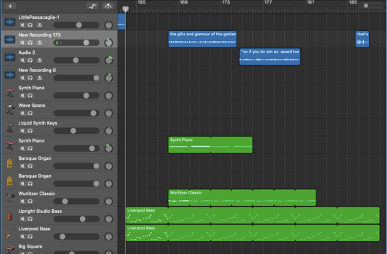
Screen shot of 3rd Section (bottom half):
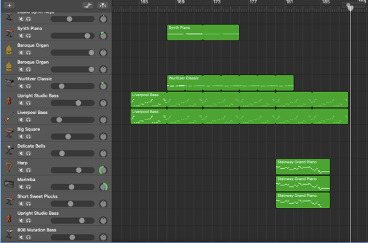
0 notes
Text
MUSC 2653 Assignment 1
Draft 1 – Submitted for feedback on 8/3/21
For my first draft, I began with some basic ideas of melody, harmony, rhythm and sound effects. I had a basic idea for 2 different melodic motifs and one chord progression (which included the harmony in chords and bass notes of the overall chord progression). I also had basic ideas of some ambient sound effects that had slight rhythmic implications, and some percussion parts outlining main beats. So far, I have composed an introduction and up to the middle of my section A. The introduction sees the first melodic motifs, and the use of ambient sound effects that contain pedal points on Eb, which had some ‘waa – waa’ rhythmic pulsations alongside the basic beats of the track. The first half of section A then contains the first two melodic ideas of the introduction but now inverted in order. In my section A, I also introduced a clear percussive layer with an electronic drum kit kick drum sound and the chord progression which contains lots of syncopations and dotted rhythms. Both the melodic ideas and rhythmic ideas I played and recorded on an acoustic piano. My teacher gave feedback regarding the need to EQ the frequencies that were blowing out with my acoustic piano recordings, but he also said that we would be addressing that more in the coming weeks’ time.
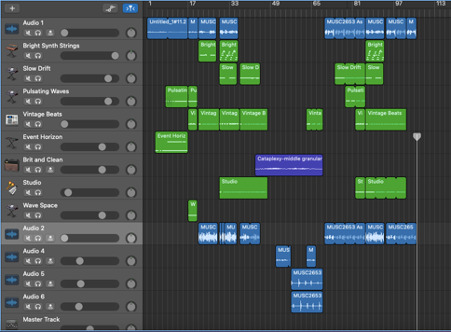
Draft 2 – Submitted for feedback on 22/3/21
For my second draft I finished the song in terms of completing the structure. From my first draft I added the rest of my Section A, a transition into Section B, my contrasting section B, and then my reprise section A’. I also added a ‘fade out’ outro at the end of the reprise. For completing the second half of my section A, I created another melodic motif with my acoustic piano, this time which explored a wider pitch range through more stepwise and leaping movements but still maintaining syncopated rhythms. I also added a few more sound effects that held and resonated out pulsations on the pitch Gb, adding to the previous concept of pedal note sound effects from my introduction. I also varied my percussion slightly, by adding some brief high-hat rhythms to my kick drum beats.
I centred my section B around a stem from Cataplexy, one that had whirring waves of electronic feedback. Around that I added some tinkering piano notes by planning slow glissandi ascending and descending at the very top end of my acoustic piano, which became a repeating riff throughout the section. I also added some cluster chords at the high end of my piano, one which utilised a cluster of black keys followed by a white key cluster. The cluster chords were in call and response to each other, and the semitonal difference between them assisted in creating the ambience and ambiguity of mood that I wanted to make of my section B. Then I finished my section A reprise, with rearrangements of all the previous material from the first section.
In terms of feedback, my teacher said that I still needed to figure out the frequencies in my recording that were blowing each other out. He suggested that aside from trying to adjust the EQ of my track, that I should try and re-record my acoustic piano parts with a proper recording device. He also suggested that I correct some misalignments with the rhythm in my chord progressions and that I make sure to separate the registers of my chord progression and melodic layers, so that they weren’t all crowded in the same octave. He also said that I should vary the colours between these harmonic and melodic layers. For the section B, he said that I should try and change the sound of my effects, including the cluster chords and glissandi, as the acoustic piano sound has been heard a lot before in my tack. He also suggested that I take the ‘guts or essential sound of the Cataplexy stem, and use it more in the background, and that to fill the gap between my section B and reprise, I should have a swelling effect.
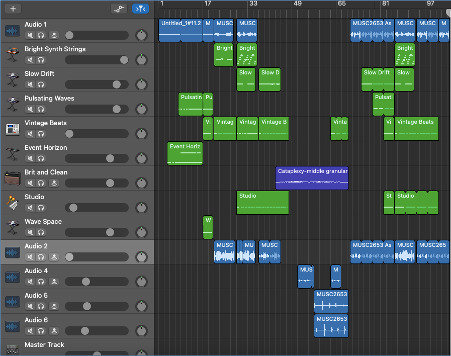
Draft 3 – Final Draft submitted:
After receiving feedback, I proceeded to change all of my recorded track layers of the acoustic piano. My teacher was pointing out that the essential issue with my recorded layers was that due to the crowded nature of my chord progression and melodic layers within one register, and the poor quality of my recording equipment, the layers were competing with each other. I re-recorded everything with a much better Zoom recorder, however the process was very lengthy and very painstaking and after doing so, my audio files were very soft once played with all the other layers in Garage band. To avoid any more hassle, I tried just to re-record all of my piano material electronically i.e., using the keyboard in Garage band for the electronic keyboards and synth keyboards. The sound was much better, with much less EQ problems. I also noticed that due to the very small pitch range that I could play on my computer keyboard in Garage band, I had to simplify my ideas and arrange them more effectively, which overall benefitted my track much more. I made sure that ideas of bass, pitch and harmony were all separate and contrasting in colour as well as clarifying what ‘ground’ they each sat in. In my section B, I also changed all my piano recordings. For the glissandi I used a Guzheng with added effects and two different types of keyboard sounds for my cluster chords, one electric and the other a synthetic organ sound. To all of these I added much more resonance, reverb and slight tremolo effects too. I think my track was much better after making it completely electronic like this.
Overall, I was inspired from the structure and section B ambience of sound from Cataplexy. I learned to keep my ideas simple and arrangement them effectively, and also consider the quality of recording equipment that I use. I learnt these lessons by facing them as creative problems, and I fixed them by finding different ways to produce them, experimenting with electronic or acoustic methods.
The creative process was all about building on what I already had. It started from the chord progression. I then made different melodic motifs that I enjoyed with the progression. I then added to the melodies in my track within my A and A’ sections by increasing the textures and sound effects.
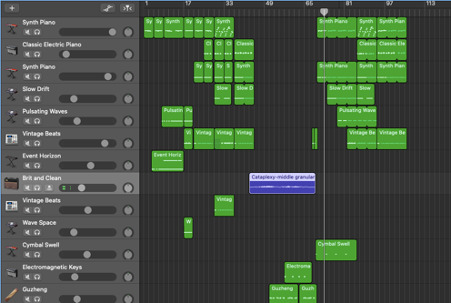
1 note
·
View note